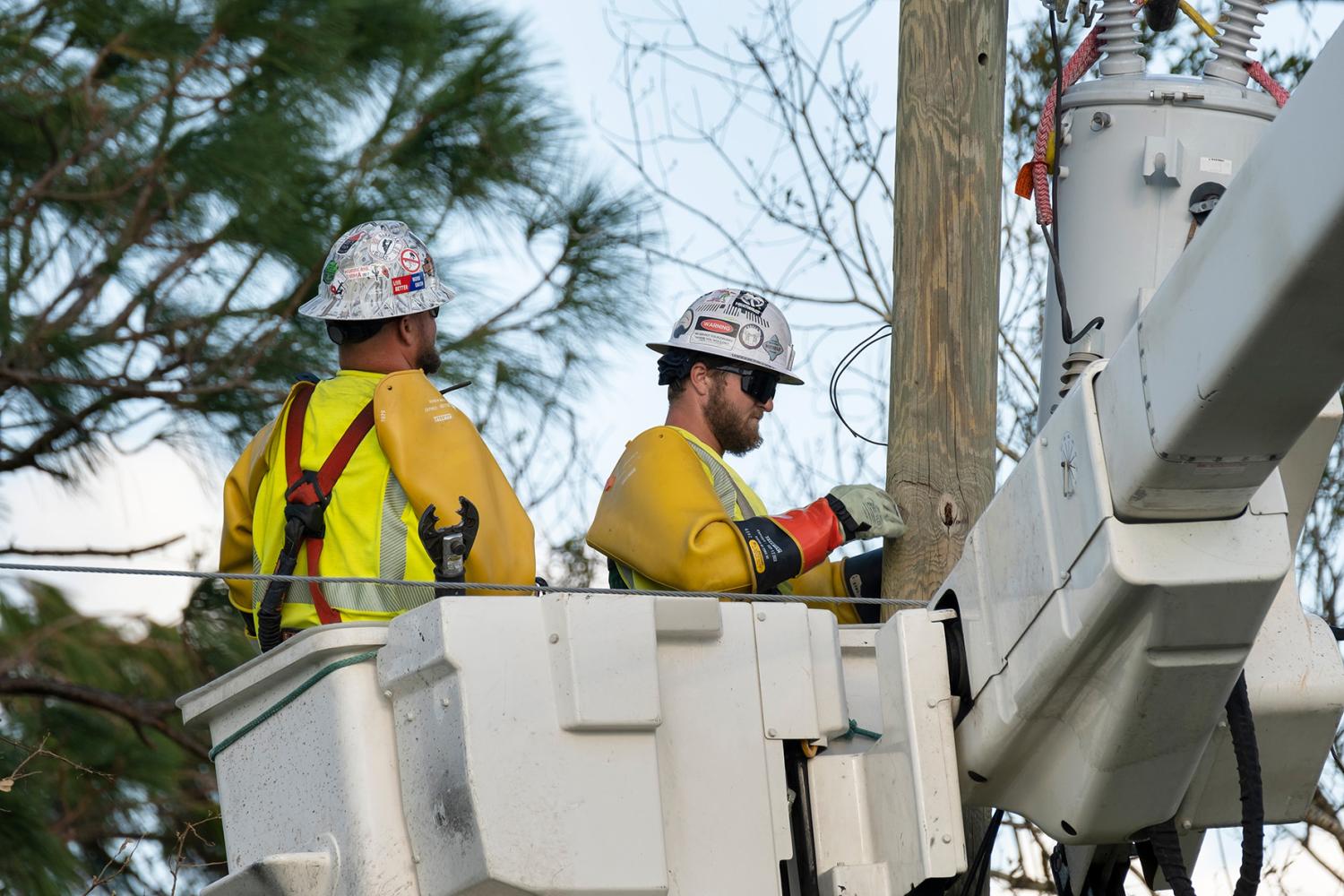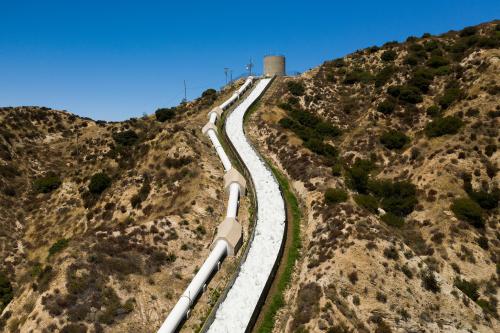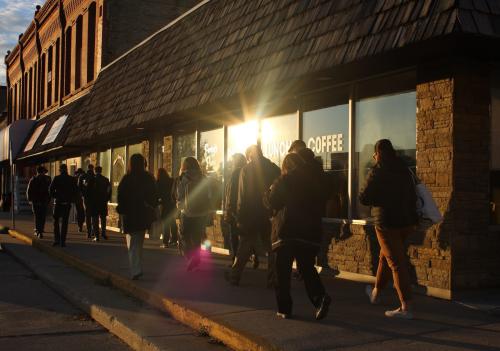Last month, the U.S. Economic Development Administration (EDA) announced a new $1.5 billion Disaster Supplemental Grant Program (DSGP) for local communities hit by natural disasters in 2023 and 2024. The EDA has a long legacy of supporting disaster recovery, often through funding individual construction projects and other economic development programs. And this year’s DSGP marks a notable evolution for the agency: the inclusion of an “Industry Transformation Path” that can provide regions with up to $50 million to invest in a strategic industry opportunity.
By linking industry development to economic resilience,1 the DSGP bears close resemblance to the suite of other place-based programs the federal government has implemented in recent years, offering nearly half of U.S. counties an opportunity to secure funding for regional economic transformation. This piece assesses the EDA’s historical role in disaster recovery, the transformative potential of place-based approaches to economic resilience, and what types of communities stand to benefit from this new funding opportunity.
The EDA’s role in helping local economies recover from natural disasters
Federal disaster declarations are a multistep process facilitated by agencies across the federal government, each with designated roles in resilience planning, short-term assistance, or long-term recovery. The EDA’s role in this interagency approach, while still relatively small within the entire federal disaster recovery budget, has expanded substantially since the inception of the Natural Disaster Recovery Framework in 2011, which designated the EDA as the lead coordinating agency for economic recovery support.
With oversight from the Federal Emergency Management Agency (FEMA), which manages immediate response assistance and implementation of emergency protective measures, the EDA is responsible for the federal government’s role in helping reinvigorate local economies in the aftermath of natural disasters. Since undertaking this role, the EDA has received supplemental congressional appropriations for regional recovery and resilience seven times, five of which have been for targeted recovery and resilience planning in communities impacted by major disasters. More than one-fifth of the EDA’s total budget authority between 2011 and 2024 came from these disaster supplementals.
Historically, the EDA’s approach to disaster recovery has focused on acute near-term needs and infrastructure restoration efforts. While addressing these immediate challenges is crucial, they may not fully address the underlying economic and fiscal challenges that leave some communities more vulnerable to disasters than others. This is why the EDA has adopted a broader vision of resilience in recent years, granting eligibility to disaster recovery projects that evolve a local economy’s industry structure to enhance competitiveness and grow quality jobs. Importantly, the EDA’s funding is a complement to other disaster mitigation programs within FEMA—two of which have been eliminated in recent months amid broader federal funding cuts.
The recent Notice of Funding Opportunity (NOFO) extends and deepens this evolution while still acknowledging the varied conditions and capabilities in communities impacted by disasters. Specifically, communities that were impacted by federally designated disasters in 2023 and 2024 will be eligible for assistance in three categories based on their “recovery stage, capacity, and long-term development vision.”
Industry transformation can aid recovery and lower vulnerabilities to future disasters
Of these three grant pillars, the Industry Transformation Path is most notable. Even as the EDA has shifted toward more placed-based approaches to investment in recent years, disaster supplemental grants (and other grants awarded through the agency’s Economic Adjustment Assistance program) have remained smaller in scope and engaged a fewer number of organizations within each grant. But with an expected award range of $20 million to $50 million, the Industry Transformation Path appears less similar to other awards made under the EDA’s disaster assistance portfolio and more akin to large, multi-project grants awarded through programs such as the Build Back Better Regional Challenge (BBBRC), Recompete Pilot Program, and Regional Technology and Innovation Hubs program. This round of disaster supplemental grants acknowledges that that the adverse effects of almost any disaster are compounded by existing distress and disinvestment—and that federally backed investments in economic development and capacity-building are critical for long-term regional growth and resiliency.
The Industry Transformation Path provides local coalitions with relatively flexible funding to grow strategic industries through investments in critical infrastructure, workforce development, innovation, and coalition-based governance. The NOFO namechecks, for example, sample project portfolios that scale a semiconductor manufacturing corridor, expand a maritime cluster through infrastructure upgrades, and evolve a food processing industry through new technologies and facilities. To execute on these investments, the EDA requires the formation of cross-sector coalitions composed of businesses, higher education institutions, economic and workforce development organizations, community-based organizations, and state, local, and/or tribal governments. In other place-based programs, bringing partners together around a well-organized project portfolio in this way has been instrumental for enhancing collaboration, aligning partners around a shared vision for economic growth, and standing up the governance structures necessary to deliver on larger-scale transformation.
Additionally, alignment between the Industry Transformation Path and these other grant programs could be particularly beneficial for communities that may have vied for, but did not receive, the nearly $41 billion in place-based investment the federal government awarded over the past five years. Even though geographic eligibility is narrower for disaster supplemental grants than for prior place-based programs, we estimate that 1,402 (45%) of U.S. counties are eligible to compete for disaster funding.2 Of these eligible counties, 855 (61%) have not received any place-based funding through major federal legislation over the last five years, and an additional 182 (13%) received only a strategic development/planning grant with no follow-on implementation funding. Communities with an investable plan but no implementation funding are prime candidates for Industry Transformation grants. And for eligible communities that did receive implementation funding, the Industry Transformation Path may provide additional opportunities to expand, accelerate, or scale existing efforts.
Disaster recovery investment can benefit a diversity of economically distressed places
Disaster supplemental grants across all of the EDA’s “paths” are designed to help communities recover to their pre-disaster conditions. The Industry Transformation Path described in June’s funding solicitation is unique in that it attempts to move beyond simple “restoration” by “[setting communities] on a path to exceed pre-disaster conditions and transform their local economies in new and vibrant ways.” This funding could provide strong benefits to communities that were experiencing economic distress before they were hit by a disaster. Of the counties estimated to be eligible for disaster assistance this year, the EDA classified nearly one-fifth (18%) as Persistent Poverty Counties (PPCs) in 2024, and 45% were in the top two quintiles in the Economic Innovation Group’s index of county-level economic distress. The EDA will consider a community’s level of economic distress in awarding funding.
The broad eligibility of economically distressed communities for disaster assistance highlights the importance of the EDA’s “resilience” priority, and why this new distinction between “restoration” and “transformation” is critical. Low-income communities—particularly those in rural areas—are disproportionately harmed by disasters. EDA grantmaking has repeatedly demonstrated a positive impact on job growth and business creation, particularly in communities with projects generating spillover effects in neighboring counties. Awards made for the purpose of industry transformation, rather than a narrow vision of recovery, both empower distressed communities and make them more resilient against natural hazards in the future.
The bottom line: This year’s Disaster Supplemental Grant Program signals a significant evolution in federal disaster recovery—one that blends short-term economic needs with longer-term economic development ambitions. By linking industry development to resilience, the EDA is recognizing that economic fragility often precedes disaster vulnerability—and that lasting recovery requires confronting both. Ahead of the March 3, 2026 application deadline for Industry Transformation grants, regions impacted by major disasters should act now to engage private sector partners, public officials, economic and workforce development practitioners, and community organizations around a cohesive theory of change for their regional economy.
-
Footnotes
- Defined by the EDA as “economic development planning or implementation projects that enhance the ability of an area to withstand and recover from adverse short-term or long-term changes in economic conditions, including effects from industry contractions or economic impacts from natural disasters.” For more information, see the NOFO.
- Excludes eligible Tribal nations and county-equivalents in Puerto Rico and other U.S. territories.
The Brookings Institution is committed to quality, independence, and impact.
We are supported by a diverse array of funders. In line with our values and policies, each Brookings publication represents the sole views of its author(s).





